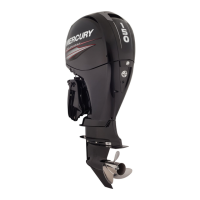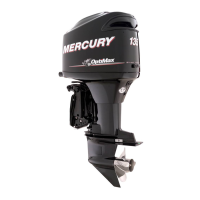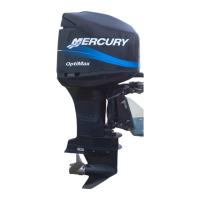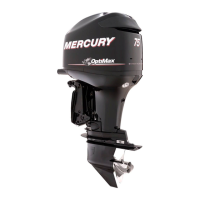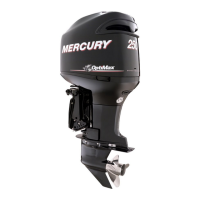GENERAL INFORMATION
Page 1C-2 90-855347R1 JANUARY 1999
Conditions Affecting Performance
Weather
Weather conditions exert a profound effect on power output of internal combustion en-
gines. Established horsepower ratings refer to the power that the engine will produce at
its rated RPM under a specific combination of weather conditions.
Corporations internationally have settled on adoption of I.S.O. (International Standards
Organization) engine test standards, as set forth in I.S.O. 3046 standardizing the compu-
tation of horsepower from data obtained on the dynamometer, correcting all values to the
power that the engine will produce at sea level, at 30% relative humidity at 77° F (25°C)
temperature and a barometric pressure of 29.61 inches of mercury.
Summer conditions of high temperature, low barometric pressure and high humidity all
combine to reduce engine power. This is reflected in decreased boat speeds – as much
as 2 or 3 mph. Nothing will regain this speed for the boater but the coming of cool, dry
weather.
In pointing out the consequences of weather effects, an engine – running on a hot, humid
summer day – may lose as much as 14% of the horsepower it would produce on a dry,
brisk spring or fall day. The horsepower that any internal combustion engine produces
depends upon the density of the air that it consumes and this density is dependent upon
the temperature of the air, its barometric pressure and water vapor (or humidity) content.
Accompanying this weather-inspired loss of power is a second but more subtle loss. At
rigging time in early spring, the engine was equipped with a propeller that allowed the
engine to run within its recommended RPM range at full throttle. With the coming of the
summer weather and the consequent drop in available horsepower, this propeller will, in
effect, become too large. Consequently, the engine operates at less than its recom-
mended RPM.
Due to the horsepower/RPM characteristics of an engine, this will result in further loss of
horsepower at the propeller with another decrease in boat speed. This secondary loss
can be regained by switching to a smaller pitch propeller that allows the engine to run
again at recommended RPM.

